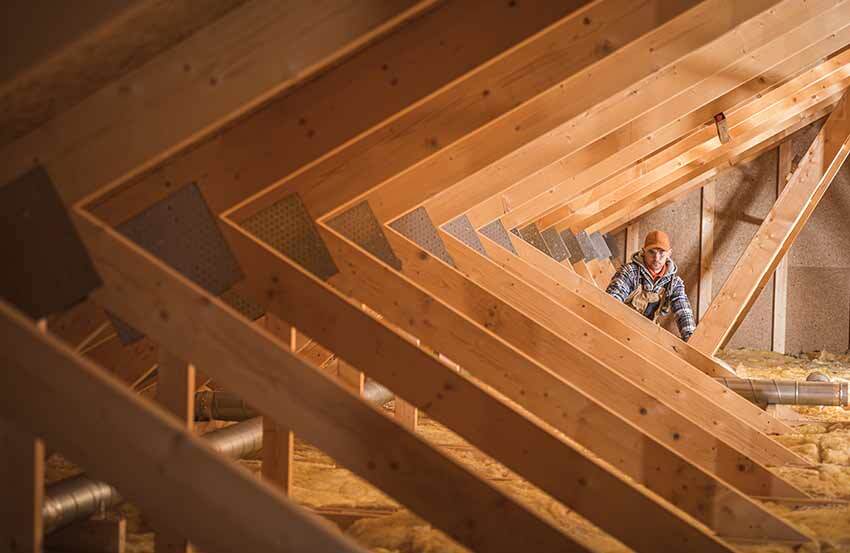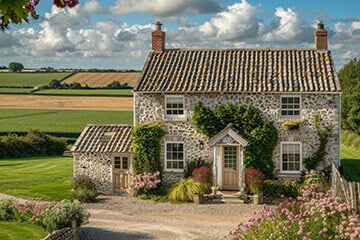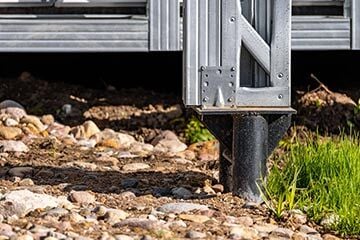Dry rot is a type of fungus called Serpula lacrymans. A fancy name for a wood-eating menace.
Dry rot can wreak havoc on your home if it's left untreated, so it's worth knowing how to spot the signs.
We'll outline the best ways to prevent dry rot happening in the first place - so you won't have to hear the words Serpula lacrymans again.

What is dry rot?
Dry rot is a type of wood-decaying fungus that causes structural damage to your home. It feeds off the cellulose in timber, causing it to be weak or brittle.
It can affect key structural elements of your home, making it unsafe and, in extreme cases, collapse.
What causes dry rot?
We don't want to spook you, but dry rot spores are everywhere. Dry rot itself, however, needs specific conditions to thrive.
Damp, poorly ventilated places are dry rot's best friend. Specifically in timber with a high moisture content, typically around 28% - 38%.
Let's take a closer look at why dry rot might set up camp in your home:
Rising damp
This is when moisture moves up from the ground into the building. Rising damp provides the perfect conditions for dry rot to take hold.
Condensation
Poor ventilation can trap moisture in certain areas, leading to condensation on wooden surfaces.
Leaks or poor drainage
Water entering through a damaged or poorly maintained roof can also be the culprit. Leaks from washing machines or dishwashers, or a blocked pipe can also cause dry rot.
Broken tiles leading to a leaky roof
Broken tiles on a roof create openings for water to enter, causing leaks and moisture build up within the roof's structure. Dry rot can thrive if there's moisture and poor ventilation.
Drains
Leaky or damaged drains can cause damp timber - perfect for dry rot fungi to thrive.
Timber embedded in or touching stone
Stone can trap moisture and provide a pathway for dry rot fungus to spread. Stone structures can also prevent good airflow, stopping timber from drying out.
Untreated, old timber
Untreated wood, especially if exposed to damp conditions, is more susceptible to dry rot.
Where’s dry rot most likely to form?
Dry rot has its favourite haunts - damp, dark corners that you might not think to check. Here are the places you're most likely to encounter dry rot:
Basements and cellars
Often damp and poorly ventilated, they're ideal breeding grounds for dry rot.
Beneath floorboards and suspended timber floors
Moisture can easily build here and have limited airflow, especially if air bricks are blocked.
Around leaking plumbing and pipes
Leaky plumbing, whether from supply lines or drainage pipes, add water to the structure. This often happens in hidden areas like under sinks or behind walls.
Roof spaces and attics
Leaky roofs can introduce moisture, and poor ventilation can trap it, leading to dry rot in rafters and other timbers.
Around windows and door frames
Leaks and condensation can create dampness around these areas.
Walls with penetrating or rising damp
These damp conditions provide the moisture and humidity that dry rot needs to thrive.
How can I spot dry rot?
If you suspect you've got dry rot in your home, it's best to get a professional to take a look. But keep your eyes peeled for the warning signs:
- Charred looking wood that becomes brittle and breaks off into cube-like chunks.
- Wood that has darkened or lightened (depending on species).
- Wood that shrinks, warps or sinks.
- Visible fungal growth. These will look like white, cotton-wool like spores.
- Mushroom-like growths, with a rusty orange or reddish colour with white outer rings.
- Spore dust. This will look like orange or brown dust around the timber.
- Grey or silvery threads growing across brickwork or plaster. This is the root of the fungus spreading in search of fresh wood.
- A damp, earthy smell.
Will a house survey pick up dry rot?
Yes, a level 2 and 3 Royal Institution of Chartered Surveyors survey (RICS) will pick up dry rot. But a level 1 won't.
These surveys will give a detailed assessment of a property's condition. You can also get specific dry rot surveys done.
These surveys will all come at a cost though. A survey is usually in the ballpark of £300-£500.
What should I do if I find it in my house?
Again, it's best to get a professional to help. But what happens when the rot has been found? Here are the likely steps a professional will take:
Investigation and assessment
Professionals will look for the source of the moisture that's causing the dry rot. This could be leaks, condensation, or poor ventilation.
Once they've found the rot, they'll check over the entire area. This will include the timber, plaster, and other structural components to assess the full scope of the dry rot.
They'll look for any other signs of timber decay, like wet rot, and find out if any other areas area at risk.
Removal and treatment
First, the professional will carefully remove all timber, plaster, and any other materials badly damaged by the rot.
Then, any visible fungal growth will be removed using industry-leading fungicides and biocides. They'll apply this stuff to the affected area.
Repair and restoration
Once the affected materials are removed, a professional will repair or replace structural timbers using pre-treated timber.
How much does it cost to fix?
The overall cost depends on a number of factors. But these can be very pricy, sometimes costing thousands of pounds in severe cases. For more minor cases, you might be looking at a figure around £200-£750.
Always ask if the treatment comes with a long term guarantee.
Does home insurance cover dry rot?
Not usually, no. Dry rot is classified as a preventable and gradual issue that comes from lack of maintenance or poor ventilation, so home insurance typically excludes it.
But if it's caused by a covered issue like flooding, a storm-damaged roof or a burst pipe, it may be covered as a secondary issue. This is known as escape of water, and if this caused the dry rot there's a good chance it's covered.
Some insurers offer additional dry rot coverage. But always check your policy documents to find out whether you're covered first.
Will dry rot affect my mortgage?
Yes, dry rot will affect your mortgage. If you're a new buyer, a lender might refuse to lend to you until the problem is sorted. You might also need a timber or damp report before you get approval. The value of the property may also be lowered.
How can I prevent dry rot forming?
Ideally, you'll want to stop dry rot from happening in the first place. Here are some of the best ways to make your home less appealing to rot:
- Fix any leaks
- Fix any damp fast
- Ensure all areas are well ventilated. Make sure extractor fans are working in bathrooms. If possible, open windows and doors to let fresh air in. This is particularly important in kitchens, laundry rooms, attics, crawlspaces, and basements.
- Don’t block air vents. These create airflow to help dry out damp areas, so make sure they aren't blocked in any way.
- Use a dehumidifier in humidity-prone rooms. This will help manage moisture levels in the air.
- Check moisture levels in potentially problematic areas like the attic, or behind appliances. You can use a hygrometer for air humidity or a moisture meter for materials like wood or drywall.
- Never let untreated wood rest on stone, brick, concrete or the ground without spacers or air gaps to separate them.
- Ensure the wood you use is treated - pressure treated or borate treated. Pressure treatment involves forcing preservatives or fire retardants deep into the wood using pressure. Borate treatment is applied as a solution or solid, to protect against decay and insects. If you need wood for outdoor structures that will be exposed to the elements, pressure-treated wood is generally the better choice. For indoor applications or areas with limited moisture exposure, borate-treated wood can be a good option.
- Recoat external wood with weather proof sealants or paint every few years. This ensures that water isn't getting through.







